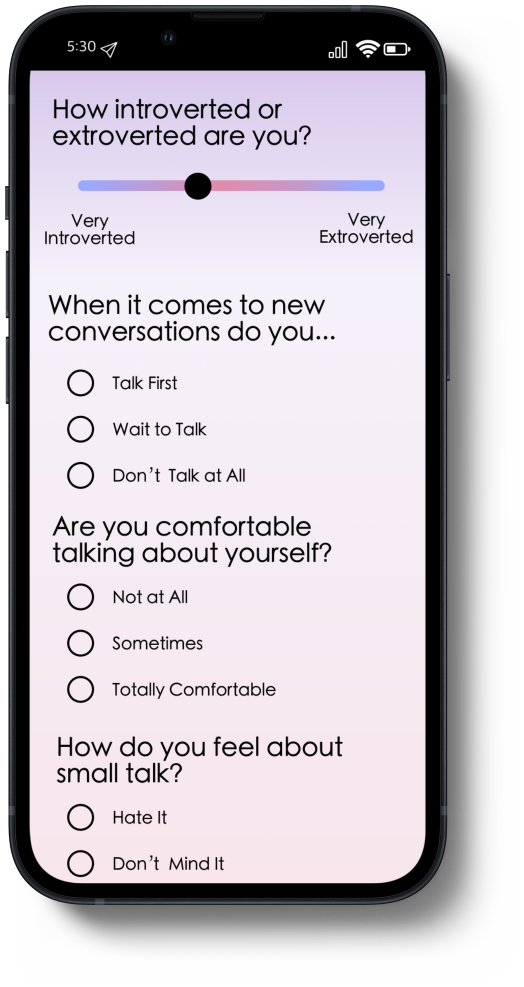Social Gatherings
An empathetically designed mobile app to help fight the loneliness epidemic
TL;DR
Social Gatherings is a mobile app dedicated to connecting individuals experiencing social anxiety to practice conversations and make new friends. Secondary research into the loneliness epidemic and empathetic design inspired the initial concept. Directed storytelling interviews about friendship confirmed traditional methods of making new friends both in person and online. A content audit of loneliness and social anxiety forums established common themes, pain points, and successes when individuals attempted to make new friends. Personas and journey maps were then created which influenced the development of app touchpoints. Wireframes and a final touchpoint journey map were created.
Overview
My Role: UX Researcher and Designer
Methods: Directed Storytelling, Content Audit, Affinity Diagramming Competitive Analysis, Personas, User Journey Mapping, Wireframing, Prototyping
Tools: Figma, Google Suite, Zoom, Keynote
Deliverables: User Personas, User Journey Maps, Touchpoint Prototypes, Touchpoint Journey Map, Presentation Video
The Goal
The idea for this project started with the question “How do adults make friends?” as it turns out there are many answers to this question, but it is something many people still struggle with. The loneliness epidemic is a very popular discussion topic in mental health circles and it is a challenge many are looking to solve. For this project, the goal was to heavily utilize primary and secondary research on the subjects of loneliness and social anxiety to develop an empathetic mobile app that could make an impact on the loneliness epidemic.
Initial Research
Further research into the loneliness epidemic needed to be conducted for two major reasons. One, it needed to be verified how widespread loneliness was to show that this is a needed service. Two, it needed to be determined who was suffering most from loneliness in order to know who the potential users would be. Multiple sources were used for this information and it was found that loneliness was very common in most people, but especially in young adults ages 18-25. This information guided further user research.
Due to the sensitive nature of loneliness and social anxiety, additional research in safe design and empathetic design was derived from “Design for Safety” by Sara PenzeyMoog and “Design for Real Life” by Eric Meyer and Sara Wachter-Boettcher.
Directed Storytelling
In order, to gain a better understanding of how people traditionally make friends, directed storytelling was done with four participants. The majority of participants indicated having a strong circle of friends. Overall it was found that typically people make friends through places like work, school, or existing communities such as friends of friends or friends of significant others.
Content Audit
A major challenge to this project was finding individuals who would be open to talk about loneliness. Along with that, it would be problematic to request someone to open up about such concerns without proper mental health resources being available during the research session. The way to navigate this challenge was to do a large content audit of online loneliness forums. It was found that social anxiety was a major contributing factor to loneliness. Social anxiety forums were then also included in the content audit. Content was divided into sections of resource recommendations, pain points, successes, meeting types, and participant quotes.
Competitive Analysis
There are already multiple online services available to assist individuals with meeting new people so a competitive analysis was completed to see how they functioned and why individuals on these loneliness forums may not have success using them. It was found that many of these services encourage in-person meetings which may be intimidating to some and difficult during a pandemic.
Personas and Journey Mapping
Personas were developed based on stories of individuals who found success with making friends and with those who struggled to make friends. From there, scenarios were written. Two journey maps were created to illustrate how these personas would navigate the current friend making resources available to them. This revealed high points and low points in the friend making process. All concept ideas were based directly off of these insights. A touchpoint strategy map was then developed to show the new user journeys through proposed app touchpoints.
Concept Wireframing
A mobile app concept was developed based on the research findings. The app would be targeted to those who experience social anxiety and who may not have access to traditional methods of making friends. Wireframes of specific touchpoints were created to display unique aspects to the app. A touchpoint strategy map was created to display and describe all touchpoints.

Survey Sketch

Survey Wireframe

Notification Sketch

Notification Wireframe

Prompt Sketch

Prompt Wireframe

Video Chat Sketch

Video Chat Wireframe

Post-Gathering Sketch

Post-Gathering Wireframe
Next Steps
It would be great to push this app idea further and look into allowing gatherings of more than two people in order to encourage group conversations. I also plan to build out an interactive prototype of the entire app.
Conclusion
This was such an interesting problem space to tackle. It’s fascinating how research can really influence design, especially when it’s a complex concept.
I love diving into challenging work spaces and would love to do the same for you! If you are looking for a UX researcher or designer feel free to out reach me.








